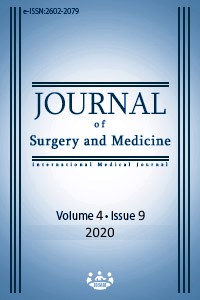Are small bore thorax catheters effective in the treatment of primary spontaneous pneumothorax?
Keywords:
pneumothorax, thoracic drain, small bore thoracic catheter, primary spontaneous pneumothoraxAbstract
Aim: The first option in the treatment of primary spontaneous pneumothorax (PSP) is still controversial. Large bore thoracic drains (LBTD) are generally preferred by clinicians. However, the use of small-bore thorax catheters (SBTC) has increased in recent years. In our study, we aimed to compare the treatment efficacy, clinical outcomes and pain levels of small and large diameter thoracic catheters used in PSP treatment. Methods: Patients over the age of 18 who presented with a diagnosis of PSP between August 2017 and August 2019 were included in the study. The patients were divided into two groups according to the application of small and large bore thorax drain. Demographic information, clinical results and pain levels of the groups were analyzed retrospectively. The duration of hospitalization, duration of drainage and Visual Analogue Scale (VAS) results were evaluated comparatively. Results: 95 male and 10 female patients with a median age of 26 (22-33) were included in the study. LBTD was applied to 47 (44.8%) and SBTC was applied to 58 (55.2%) of the patients. Recurrence was observed in 6 (12.8%) of LBTD group and in 4 (6.9%) SBTC group. VAS scores, drainage time, hospital stay were significantly less in patients with small-sized drainage. Conclusion: SBTC application is easy to apply, causes less pain, has shorter drainage time and duration of hospital stay. It is as effective as traditional thoracic drains in the treatment of PSP.
Downloads
References
Shields TW, Cicero JL, Ponn RB, RuschVW, editors. General Thoracic Surgery. 6th ed. Philadelphia: Lippincott Williams&Wilkins; 2005.
Sahn SA, Heffner JE. Spontaneous pneumothorax. N Engl J Med. 2000 Mar 23;342(12):868-74. doi: 10.1056/NEJM200003233421207.
Donahue DM, Wright CD, Viale G, Mathisen DJ. Resection of pulmonary blebs and pleurodesis for spontaneous pneumothorax. Chest. 1993;104(6):1767-9. doi: 10.1378/chest.104.6.1767.
Rivas de Andrés JJ, Jiménez López MF, Molins López-Rodó L, Pérez Trullén A, Torres Lanzas J; Spanish Society of Pulmonology and Thoracic Surgery. Normativa sobre el diagnóstico y tratamiento del neumotórax espontáneo [Guidelines for the diagnosis and treatment of spontaneous pneumothorax]. Arch Bronconeumol. 2008;44(8):437-48. Spanish. doi: 10.1016/s1579-2129(08)60077-4.
Melton LJ 3rd, Hepper NG, Offord KP. Incidence of spontaneous pneumothorax in Olmsted County, Minnesota: 1950 to 1974. Am Rev Respir Dis. 1979;120(6):1379-82. doi: 10.1164/arrd.1979.120.6.1379.
Balta C, Kuzucuoglu M. Conservative Treatment Approach in Primary Spontaneous Pneumothorax. J Coll Physicians Surg Pak. 2020;30(2):168-71. doi: 10.29271/jcpsp.2020.02.168.
Cho S, Lee EB. Management of primary and secondary pneumothorax using a small-bore thoracic catheter. Interact Cardiovasc Thorac Surg. 2010;11(2):146-9. doi: 10.1510/icvts.2009.226589.
Filosso PL, Sandri A, Guerrera F, Ferraris A, Marchisio F, Bora G, et al. When size matters: changing opinion in the management of pleural space—the rise of small-bore pleural catheters. J Thorac Dis. 2016;8(7):E503-E510. doi: 10.21037/jtd.2016.06.25.
Light RW. Pneumothorax. In: Pleural diseases. Baltimore: Williams & Wilkins; 2007. p. 306–39.
Park JK, Kraus FC, Haaga JR. Fluid flow during percutaneous drainage procedures: an in vitro study of the effects of fluid viscosity, catheter size, and adjunctive urokinase. AJR Am J Roentgenol. 1993;160(1):165-9. doi: 10.2214/ajr.160.1.8416618
MacDuff A, Arnold A, Harvey J; BTS Pleural Disease Guideline Group. Management of spontaneous pneumothorax: British Thoracic Society Pleural Disease Guideline 2010. Thorax. 2010;65 Suppl 2:ii18-31. doi: 10.1136/thx.2010.136986.
Baumann MH, Strange C, Heffner JE, Light R, Kirby TJ, Klein J, et al, ;AACP Pneumothorax Consensus Group. Management of spontaneous pneumothorax: an American College of Chest Physicians Delphi consensus statement. Chest. 2001;119(2):590-602. doi: 10.1378/chest.119.2.590.
Çardak ME, Özer KB, Cesur EE, Özdemir A, Evman RS, Demirhan R. Small Bore Thoracic Catheter Versus Chest Tube in Treatment of Primary Spontaneous Pneumothorax. SCIE. 2019;30(4):301-5. doi: 10.14744/scie.2019.84429.
Korczyński P, Górska K, Nasiłowski J, Chazan R, Krenke R. Comparison of Small Bore Catheter Aspiration and Chest Tube Drainage in the Management of Spontaneous Pneu-mothorax. Adv Exp Med Biol. 2015;866:15-23. doi:10.1007/5584_2015_146.
Rozenman J, Yellin A, Simansky DA, Shiner RJ. Re-expansion pulmonary oedema following spontaneous pneumothorax. Respir Med. 1996;90(4):235-8. doi: 10.1016/s0954-6111(96)90293-0.
Tsai TM, Lin MW, Li YJ, Chang CH, Liao HC, Liu CY, et al. The Size of Spontaneous Pneumothorax is a Predictor of Unsuccessful Catheter Drainage. Sci Rep. 2017:15;7(1):181. doi: 10.1038/s41598-017-00284-8.
Joh HK, Moon DH, Lee S. Efficacy and Cost-Effectiveness of Portable Small-Bore Chest Tube (Thoracic Egg Catheter) in Spontaneous Pneumothorax. Korean J Thorac Cardiovasc Surg. 2020;5;53(2):49-52. doi: 10.5090/kjtcs.2020.53.2.49. PMID: 32309202.
Luketich JD, Kiss M, Hershey J, Urso GK, Wilson J, Bookbinder M, et al. Chest tube insertion: a prospective evaluation of pain management. Clin J Pain. 1998;14(2):152-4. doi: 10.1097/00002508-199806000-00011.
Fang M, Liu G, Luo G, Wu T. Does pigtail catheters relieve pneumothorax?: A PRISMA-compliant systematic review and meta-analysis. Medicine (Baltimore). 2018;97(47):e13255. doi: 10.1097/MD.0000000000013255.
Rahman NM, Maskell NA, Davies CW, Hedley EL, Nunn AJ, Gleeson FV, et al. The re-lationship between chest tube size and clinical outcome in pleural infection. Chest. 2010;137(3):536-43. doi: 10.1378/chest.09-1044.
Downloads
- 389 786
Published
Issue
Section
How to Cite
License
Copyright (c) 2020 Cenk Balta, İsmail Karacaoğlu, Duygu Mergan, Ali Cem Yekdeş
This work is licensed under a Creative Commons Attribution-NonCommercial-NoDerivatives 4.0 International License.
















